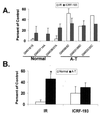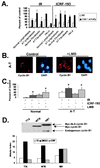The human decatenation checkpoint
- PMID: 11593014
- PMCID: PMC59764
- DOI: 10.1073/pnas.221430898
The human decatenation checkpoint
Abstract
Chromatid catenation is actively monitored in human cells, with progression from G(2) to mitosis being inhibited when chromatids are insufficiently decatenated. Mitotic delay was quantified in normal and checkpoint-deficient human cells during treatment with ICRF-193, a topoisomerase II catalytic inhibitor that prevents chromatid decatenation without producing topoisomerase-associated DNA strand breaks. Ataxia telangiectasia (A-T) cells, defective in DNA damage checkpoints, showed normal mitotic delay when treated with ICRF-193. The mitotic delay in response to ICRF-193 was ablated in human fibroblasts expressing an ataxia telangiectasia mutated- and rad3-related (ATR) kinase-inactive ATR allele (ATR(ki)). BRCA1-mutant HCC1937 cells also displayed a defect in ICRF-193-induced mitotic delay, which was corrected by expression of wild-type BRCA1. Phosphorylations of hCds1 or Chk1 and inhibition of Cdk1 kinase activity, which are elements of checkpoints associated with DNA damage or replication, did not occur during ICRF-193-induced mitotic delay. Over-expression of cyclin B1 containing a dominant nuclear localization signal, and inhibition of Crm1-mediated nuclear export, reversed ICRF-193-induced mitotic delay. In combination, these results imply that ATR and BRCA1 enforce the decatenation G(2) checkpoint, which may act to exclude cyclin B1/Cdk1 complexes from the nucleus. Moreover, induction of ATR(ki) produced a 10-fold increase in chromosomal aberrations, further emphasizing the vital role for ATR in genetic stability.
Figures





Similar articles
-
Revised genetic requirements for the decatenation G2 checkpoint: the role of ATM.Cell Cycle. 2010 Apr 15;9(8):1617-28. doi: 10.4161/cc.9.8.11470. Epub 2010 Apr 15. Cell Cycle. 2010. PMID: 20372057 Free PMC article.
-
ATR enforces the topoisomerase II-dependent G2 checkpoint through inhibition of Plk1 kinase.J Biol Chem. 2002 Sep 27;277(39):36832-8. doi: 10.1074/jbc.M206109200. Epub 2002 Jul 29. J Biol Chem. 2002. PMID: 12147700
-
Degradation of ATM-independent decatenation checkpoint function in human cells is secondary to inactivation of p53 and correlated with chromosomal destabilization.Cell Cycle. 2002 May-Jun;1(3):210-9. Cell Cycle. 2002. PMID: 12429935
-
Replication checkpoint: preventing mitotic catastrophe.Curr Biol. 2001 Feb 20;11(4):R121-4. doi: 10.1016/s0960-9822(01)00057-4. Curr Biol. 2001. PMID: 11250164 Review.
-
Human topoisomerase II function, tyrosine phosphorylation and cell cycle checkpoints.Proc Soc Exp Biol Med. 1998 Mar;217(3):327-34. doi: 10.3181/00379727-217-44240. Proc Soc Exp Biol Med. 1998. PMID: 9492343 Review.
Cited by
-
p53-Dependent but ATM-independent inhibition of DNA synthesis and G2 arrest in cadmium-treated human fibroblasts.Toxicol Appl Pharmacol. 2007 Jan 15;218(2):174-85. doi: 10.1016/j.taap.2006.10.031. Epub 2006 Nov 11. Toxicol Appl Pharmacol. 2007. PMID: 17174997 Free PMC article.
-
Discovery of cellular regulation by protein degradation.J Biol Chem. 2008 Dec 12;283(50):34469-89. doi: 10.1074/jbc.X800009200. Epub 2008 Aug 15. J Biol Chem. 2008. PMID: 18708349 Free PMC article. No abstract available.
-
DNA topoisomerase II and its growing repertoire of biological functions.Nat Rev Cancer. 2009 May;9(5):327-37. doi: 10.1038/nrc2608. Epub 2009 Apr 20. Nat Rev Cancer. 2009. PMID: 19377505 Free PMC article. Review.
-
Topoisomerase II SUMOylation activates a metaphase checkpoint via Haspin and Aurora B kinases.J Cell Biol. 2020 Jan 6;219(1):e201807189. doi: 10.1083/jcb.201807189. J Cell Biol. 2020. PMID: 31712254 Free PMC article.
-
Analysis of inhibition of topoisomerase IIalpha and cancer cell proliferation by ingenolEZ.Cancer Sci. 2010 Feb;101(2):374-8. doi: 10.1111/j.1349-7006.2009.01408.x. Cancer Sci. 2010. PMID: 20175785 Free PMC article.
References
-
- Hartwell L H, Kastan M B. Science. 1994;266:1821–1828. - PubMed
-
- Kaufmann W K, Paules R S. FASEB J. 1996;10:238–247. - PubMed
-
- Paulovich A G, Toczyski D P, Hartwell L H. Cell. 1997;88:315–321. - PubMed
-
- Hartwell L H, Weinert T A. Science. 1989;246:629–634. - PubMed
-
- Ohtsubo M, Kai R, Furuno N, Sekiguchi T, Sekiguchi M, Hayashida H, Kuma K, Miyata T, Fukushige S, Murotsu T. Genes Dev. 1987;1:585–593. - PubMed
Publication types
MeSH terms
Substances
Grants and funding
LinkOut - more resources
Full Text Sources
Other Literature Sources
Research Materials
Miscellaneous

